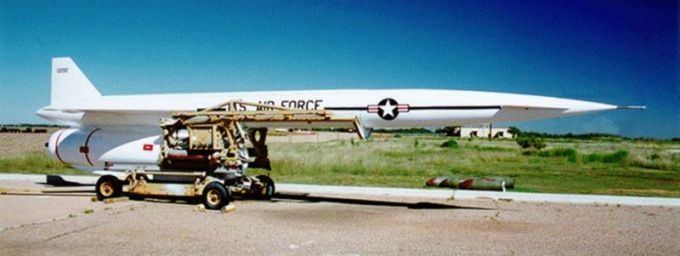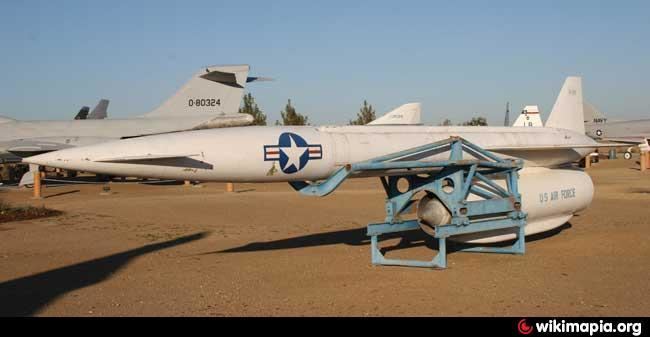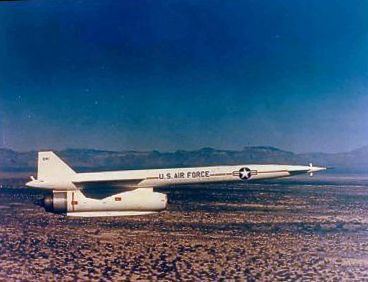Type Cruise Missile In service September 13, 1960 Produced April 1959 Retired 1976 Height 2.84 m First flight April 1959 | Unit cost $690,073 Introduced December 1959 Total length 13 m Operational range 1.263 million m | |
 | ||
Weight 4,603 kilograms (10,147 lb). | ||
Agm 28 hound dog
The North American Aviation AGM-28 Hound Dog was a supersonic, turbojet-propelled, air-launched cruise missile developed in 1959 for the United States Air Force. It was primarily designed to be capable of attacking Soviet ground-based air defense sites prior to a potential air attack by B-52 Stratofortress long range bombers during the Cold War. The Hound Dog was first given the designation B-77, then redesignated GAM-77, and finally as AGM-28. It was conceived as a temporary standoff missile for the B-52, to be used until the GAM-87 Skybolt air-launched ballistic missile was available. Instead, the Skybolt was cancelled within a few years and the Hound Dog continued to be deployed for a total of 15 years until its replacement by newer missiles, including the AGM-69 SRAM and the AGM-86 ALCM.
Contents
- Agm 28 hound dog
- Development
- Design
- Operational history
- Numbers in Service
- Variants
- Operator
- Survivors
- Popular culture
- References

Agm 28 hound dog
Development

During the 1950s the US became aware of developments regarding the Soviet Union's surface-to-air missiles (SAMs), notably at large installations being constructed around Moscow. At the time the entire nuclear deterrent of the United States was based on manned strategic bombers, both with the U.S. Air Force and the U.S. Navy, and the deployment of large numbers of SAMs placed this force at some risk of being rendered ineffective. One solution to this problem is to extend the range of the bomb, either through glide bomb techniques, or more practically, by mounting them in a short-to-medium-range missile.
The Air Force's solution to this problem was the introduction of stand-off missiles. Since the Soviet air-defenses were static and easy to spot from aerial reconnaissance or satellite reconnaissance photos, the plan was to use a long-range cruise missile to attack these air-defense bases before the bombers got into range of them. The SA-2 Guideline missile had a maximum range of about 30 kilometers at that time, but since the bombers would be approaching the sites, their own guided missiles would have to be launched well-before it entered this SAM range. If the American missile was to be used to attack enemy air bases as well, an extended range of several hundred kilometers would be needed. A missile with these capabilities was called for in General Operational Requirement 148, which was released on March 15, 1956, known as WS-131B. GOR 148 called for a supersonic air-to-surface cruise missile with a weight of not more than 5,700 kilograms (12,500 lb) (fully fueled and armed) to be carried in pairs by the B-52 Stratofortress. Each B-52 would carry two of the missiles, one under each wing, on a pylon located between the B-52's fuselage and its inboard pair of engines.
Both Chance Vought and North American Aviation submitted GAM-77 proposals to the USAF in July 1957, and both based on their earlier work on long-range ground-launched cruise missiles. Vought's submission was for an air-launched version of the Regulus missile, developed for the US Navy, while North American's was adapted from their Navaho missile. On August 21, 1957, North American Aviation was awarded a contract to develop Weapon System 131B, which included the Hound Dog missile.
The importance of Hound Dog in penetrating the Soviet air-defense system was later described by Senator John F. Kennedy in a speech to the American Legion convention in Miami, Florida, on October 18, 1960: "We must take immediate steps to protect our present nuclear striking force from surprise attack. Today, more than 90 percent of our retaliatory capacity is made up of aircraft and missiles which have fixed, un-protectable bases whose location is known to the Russians. We can only do this by providing SAC with the capability of maintaining a continuous airborne alert, and by pressing projects such as the Hound Dog air-ground missile, which will enable manned bombers to penetrate Soviet defenses with their weapons".
Design
The Hound Dog missile's airframe was an adaptation of technology developed in the SM-64 Navaho missile, adapted for launching from the B-52. The Hound Dog's design was based on that of the Navaho G-38 missile, which featured small delta wings and forward canards.
A Pratt & Whitney J52-P-3 turbojet propelled the Hound Dog, instead of Navaho's ramjet engine. The J52 engine was located in a pod located beneath the rear fuselage, giving it an appearance similar to the Lockheed X-7 high-speed experimental drone. The J52-P-3 used in the Hound Dog, unlike J52's installed in aircraft like the A-4 Skyhawk or the A-6 Intruder, was optimized to run at maximum power during the missile's flight. As a result, the Hound Dog's version of the J52 had a short operating lifetime of only six hours. However, in combat, the Hound Dog was expected to self-destruct in less than six hours.
A derivative of the Navaho's NAA Autonetics Division N-6 inertial navigation system (INS), the N5G, was used in the Hound Dog. A Kollsman Instruments Co. star tracker located in the B-52's pylon was used to correct inertial navigation system orientation errors with celestial observations while the Hound Dog was being carried by the B-52. The INS could also be used to determine the bomber's position after the initial calibration and "leveling" process, which took about 90 minutes. The Hound Dog had a circular error probable (CEP) of 3.5 kilometres (2.2 mi), which was acceptable for a weapon equipped with a nuclear warhead.
The thermonuclear warhead carried by the Hound Dog was the W28 Class D. The W28 warhead could be preset to yield an explosive power of between 70 kilotons and 1.45 megatons. Detonation of the Hound Dog's W28 warhead could be programmed to occur on impact (ground burst) or air burst at a preset altitude. An air burst would have been used against a large area, soft target. A surface impact would have been used against a hard target such as a missile site or command and control center.
The Hound Dog could be launched from the B-52 Stratofortress at high altitudes or low altitudes, but not below 1,500 metres (5,000 ft) in altitude. Initially, three different flight profiles for the Hound Dog were available for selection by the commander and the bombardier of the bomber (though other options were added later):
The first air-drop test of a dummy Hound Dog was carried out in November 1958. 52 GAM-77A missiles were launched for testing and training purposes between 23 April 1959 and 30 August 1965. Hound Dog launches occurred at Cape Canaveral Air Force Station, at Eglin Air Force Base, Florida, and at the White Sands Missile Range, New Mexico.
The Hound Dog missile's development was completed in only 30 months. North American received a production contract to build Hound Dogs on 16 October 1958. The first production Hound Dog missile was then delivered to the Air Force on 21 December 1959. 722 Hound Dog missiles were produced by North American Aviation before its production of them ended in March 1963.
In May 1961, an improved Hound Dog missile was test-flown for the first time. This upgrade incorporated improvements to reduce its radar cross-section. The Hound Dog already had a low head-on radar cross-section because of its highly swept delta wings. This low radar cross-section was lowered further by replacing its nose cap, its engine intake spike, its engine duct with new radar-absorbent material components that scattered or absorbed radar energy. It has been reported that these radar cross-section improvements were removed as Hound Dogs were withdrawn from service.
The GAM-77A version of the GAM-77 also included a new Kollsman Instruments KS-140 star tracker that was integrated with the N-6 inertial navigation system. This unit replaced the star tracker that had been located in the B-52's wing pylon. The fuel capacity of the GAM-77A was increased during this upgrade. A radar altimeter was added to the missile to provide (vertical) terrain-following radar capability to the Hound Dog. 428 Hound Dog missiles were upgraded to the GAM-77A configuration by North American.
66 GAM-77A Hound Dog missiles were launched for testing and training up through April 1973.
In June 1963 the GAM-77 and GAM-77A were re-designated AGM-28A and AGM-28B, respectively.
In 1971, a Hound Dog missile was test-flown with a newly developed Terrain Contour Matching (TERCOM) navigation system. Reportedly, the designation AGM-28C was reserved for this version of the Hound Dog if development had been continued. While a Hound Dog with TERCOM was never deployed, this technology, with much better electronics and digital computers, was later used in both the Air Force's Air Launched Cruise Missile and the Navy's Tomahawk (missile).
In 1972, the Bendix Corporation was awarded a contract to develop an anti-radiation missile passive radar seeker to guide the Hound Dog missile to antennas transmitting radar signals. A Hound Dog with this radar seeker was test-flown in 1973, but never mass-produced.
Operational history
On December 21, 1959, General Thomas S. Power, the Commander in Chief of the U.S. Air Force's Strategic Air Command (SAC), formally accepted the first production Hound Dog missile. Just two months later in February, SAC test-launched its first unarmed Hound Dog at Eglin Air Force Base.
In July 1960, the Hound Dog reached initial operational capability with the first B-52 unit. The Hound Dog was used on airborne alert for the first time in January 1962. In 1962, SAC activated missile maintenance squadrons to provide maintenance for both the Hound Dog and the ADM-20 Quail decoy missile. Full operational capability was achieved in August 1963 when 29 B-52 bomber wings were operational with the Hound Dog.
In 1960, SAC developed procedures so that the B-52 could use the Hound Dog's J52 engine for additional thrust while the missile was located on the bomber's two pylons. This helped heavily laden B-52s fly away from their airbases faster, before enemy nuclear weapons obliterated them. The Hound Dog could then be refueled from the B-52's wing fuel tanks.
One Hound Dog missile crashed near the town of Samson, Alabama, when it failed to self-destruct after a test launch from Eglin Air Force Base, Florida. In 1962, a Hound Dog was accidentally dropped to the ground during an underwing systems check.
In May 1962, operation "Silk Hat" was conducted at Eglin Air Force Base. During this exercise, a Hound Dog test launch was conducted before an audience of national and international dignitaries headed by President John F. Kennedy and Vice-President Lyndon B. Johnson.
On September 22, 1966, Secretary of Defense Robert McNamara recommended retiring all of the remaining Hound Dog missiles, within a few years. The Hound Dogs would be retained pending the outcome of the Terrain Contour Matching (TERCOM) guidance system development program. Secretary McNamara's recommendation was not acted upon, and the Hound Dog remained in service.
After thirteen years of service with the Air Force, the last Hound Dog missile was removed from alert deployment on June 30, 1975. The Hound Dog missiles were kept in dead storage for a number of years. The last Hound Dog was retired for scrapping on June 15, 1978, from the 42nd Bomb Wing at Loring Air Force Base, Maine.
No Hound Dog missile was ever used in combat, since it was strictly a weapon for nuclear warfare.
Numbers in Service
The number of Hound Dog missiles in service, by year:
Variants
Operator
Survivors
All of the surviving missiles are located in the contiguous United States
Popular culture
Where it received the name Hound Dog has been the source of argument for decades. In recent years however people have given credit to fans in the Air Force of Elvis Presley's version of "Hound Dog".
